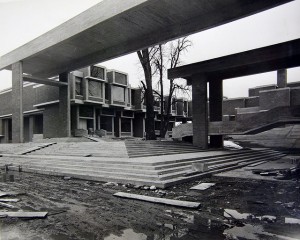 Like most people I am dismayed at the demolition of Paul Rudolph’s Orange County Government Center. But I am more dismayed by the thought that we have not learned the lesson that this Sixties building has to teach. Rudolph often stepped over the line between expression and functionality, and any designer who does so should not be surprised that his/her artifact does not gain the affection of its users. I still have my old wooden swivel office chair, but my Wassily Chair is long gone. There is another lesson that the Orange County building should teach us. Exposed concrete, in this case mostly patterned concrete blocks, is not a good finish material. It weathers badly on the exterior, and it is unpleasant on the interior. In the 1960s, exposed concrete was all the rage—so was cigarette smoking, gas-guzzling cars, asbestos cement, and lead-based paint. We now see that the last four were mistakes. So was concrete. It is a fine structural material, and OK in parking garages and stadiums (especially in the hands of a master like Nervi), but not a fit replacement for brick, stone, or wood as cladding or interior finish. There are already signs that, in a nostalgic rush to preserve exposed concrete buildings of the Sixties, we are trying to convince ourselves that concrete really is an acceptable finish material. That it’s just a matter of taste. It isn’t—it was a mistake that shouldn’t be repeated. Which raises a perplexing question: How does one preserve a mistake?
Like most people I am dismayed at the demolition of Paul Rudolph’s Orange County Government Center. But I am more dismayed by the thought that we have not learned the lesson that this Sixties building has to teach. Rudolph often stepped over the line between expression and functionality, and any designer who does so should not be surprised that his/her artifact does not gain the affection of its users. I still have my old wooden swivel office chair, but my Wassily Chair is long gone. There is another lesson that the Orange County building should teach us. Exposed concrete, in this case mostly patterned concrete blocks, is not a good finish material. It weathers badly on the exterior, and it is unpleasant on the interior. In the 1960s, exposed concrete was all the rage—so was cigarette smoking, gas-guzzling cars, asbestos cement, and lead-based paint. We now see that the last four were mistakes. So was concrete. It is a fine structural material, and OK in parking garages and stadiums (especially in the hands of a master like Nervi), but not a fit replacement for brick, stone, or wood as cladding or interior finish. There are already signs that, in a nostalgic rush to preserve exposed concrete buildings of the Sixties, we are trying to convince ourselves that concrete really is an acceptable finish material. That it’s just a matter of taste. It isn’t—it was a mistake that shouldn’t be repeated. Which raises a perplexing question: How does one preserve a mistake?


An excellent question! In architecture school in the 1980s, at MIT, we got into spirited discussions of the odd stuff Frank Gehry and Robert Venturi did at the time (before Gehry really went off the deep end), including using chain-link fencing as some sort of screen on a dwelling — obviously not decorative, but what? Some of my classmates believed that we could use any material any way we wished, as if materials do not have any pre-conceived identities; I wish I had thought, at the time, of asking them if we could use barbed wire with such freedom, as if it exists independent of its connotations. Might Mr. Rybczynski consider a series of essays on the many, many mistakes like this we have made in the Modern and post-Modern eras? I would submit mirrored glass (at least in the absence of any other exterior finish) and many uses of plastics as possible subjects —